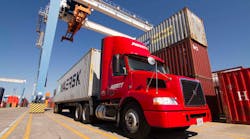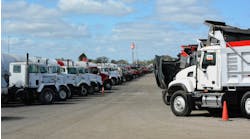An annual survey conducted by transportation conglomerate Averitt Express found that truck capacity is going to be the “primary hurdle” for shippers this year, particularly with full-load transportation.
Based on a poll of 1,600 shippers across a wide variety of industries in late 2017, Averitt’s State of The North American Supply Chain survey found that nearly one in five respondents experienced capacity issues last year – with capacity issues nearly doubling in comparison to 2016.
That’s occurring as freight demand continues to spike as, according to the survey, nearly 76% of the respondents expect their shipment volumes to increase in 2018.
The primary forces at play in the capacity crunch according to Averitt’s poll are the electronic logging device (ELD) mandate, the ongoing truck driver shortage – which the company said “shows no signs of slowing down” – and manufacturing growth that is putting more pressure on truckload capacity throughout North America.
“Capacity is definitely the big ticket item now,” Brad Brown, Averitt's marketing and communications manager, explained to Fleet Owner.
“We are seeing more moves by air and rail and that has really opened our eyes, that trend,” he added. “As long as those modes meet the shipper’s transit needs and are dependable, they [shippers] are open to exploring them.”
In comparison last year’s survey, data from Averitt’s current poll showed a 22% increase in the number of shippers planning to use air services and a 28% increase of those that plan to use rail services in 2018.
The motor carrier added that 2017 was a “record-breaking year” for air cargo transportation, with November 2017 numbers tracking shipments from Europe to North America recording a 28% year-over-year increase.
Rail carload and intermodal volumes also rebounded in 2017 from lower levels, with industry experts predicting that 2018 will bring about more gains for intermodal shipments.
Brown noted that rail capacity shouldn’t be an issue, in most cases, as the major railroad operators have been preparing ahead of time to allocate equipment and labor as needed.
“We also have relationships with all the major rail lines; we have really tried over the last 20 years to look at things the way a 3PL [third party logistics company] would in terms what makes the most sense for the customer,” he explained.
“If transit time is their number one need, obviously, we’re looking at TL and LTL,” he said. “Rail options with intermodal become involved if shipment times are more deferred. We always want to have a service mindset: to be humble and hungry and work to find solutions.”
Railroad operators themselves are also reporting a big uptick in demand for intermodal services due to the tightness of trucking capacity
“I think we're in a very good place right now; in our intermodal bids people are more receptive to intermodal because of the tight labor market, because of the tight driver shortage,” noted Patrick Ottensmeyer, president and CEO of the Kansas City Southern rail line, during an earnings call with analysts earlier this month.
“They're more receptive to our solutions [and] we're giving them much more complex solutions that they have for their supply chains,” he said. “So we feel very comfortable that we're going to have a good year and that we have a great product out there in the marketplace.”
“Certainly the driver shortage is the big issue: it is the issue everyone in trucking is looking at,” added Averitt’s Brown. “That is definitely a more challenging issue for the over-the-road side of our operation. We need to look at ways not just to fill seats but to bring in quality, professional drivers.”
He pointed out that the truck capacity problem is really a driver “quality of life issue” now. “Trucking is a tough business,” Brown said. “We try to get out drivers home every week, but that also means they are away from their families five to six days at a time.”
Other findings for Averitt’s annual shipper survey include:
- Shippers that cited freight damages as a major challenge declined by nearly 10 percentage points year-over-year. “We have done a lot of customer education about proper loading/stacking of freight and we think that has helped reduce the damage issue,” Brown noted. “Two-way communication with the customer is essential; we are trying to maintain that especially as capacity gets tighter.
- On-time service issues also dropped by more than four percentage points year-over-year.
- Import and export services grew by more than 25% each in 2017 versus 2016, according to the poll. In terms of North American trade, Averitt’s survey showed that shippers who used cross-border services between the U.S. and Canada climbed to nearly 23% – a 4.89 percentage point increase over 2016 – while use of U.S.-Mexico services increased 16%, which is a 4.22 percentage point jump from 2016.
- According to international shippers in the poll, the biggest “logistical roadblock” last year turned out to be customs clearance. Approximately 33% of respondents said they had challenges with customs clearance in 2017 – a 4.58 percentage point increase over 2016.



